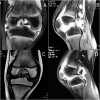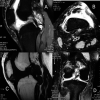Monoarticular synovitis of knee: dealing with the dilemma
- PMID: 33306021
- PMCID: PMC7731910
- DOI: 10.1051/sicotj/2020044
Monoarticular synovitis of knee: dealing with the dilemma
Abstract
Introduction: Chronic synovitis involving a single large joint remains a diagnostic dilemma. We present 61 cases of chronic synovitis of the knee, followed prospectively for 2 years. The study focuses on the diagnosis, management, and histopathological correlation.
Methods: We prospectively studied 61 patients with chronic mono-articular synovitis of the knee joint, between July 2016 and September 2017. All patients underwent plain radiographs, magnetic resonance imaging, and arthroscopic examination with synovial biopsy. Further treatment was based on findings of histopathological examination.
Results: The average duration of symptoms was 7.72 ± 4.34 months. The mean age at presentation was 29.93 ± 15.56 years. Results of histopathological examination showed chronic nonspecific inflammation in 28 patients (46%), features suggesting tubercular infection in 19 patients (31%), pigmented villonodular synovitis in seven patients (11.5%), rheumatoid arthritis in three (5%) patients, acute inflammation in three (5%) patients and findings suggestive of synovial chondromatosis in one (1.5%) patient. Treatment was based on histopathological results. Intra-articular injections of methylprednisolone (80 mg depot preparation) were given to all patients with nonspecific synovitis and rheumatoid arthritis. Anti-tubercular treatment was started for patients with tubercular synovitis. Complete arthroscopic/open synovectomy followed by radiotherapy was carried out for patients with pigmented villonodular synovitis. Non-steroidal anti-inflammatory drugs are used for patients with acute on chronic inflammation. All patients had symptomatic relief and functional improvement in further follow-up.
Discussion: Histopathological reporting remains the mainstay for diagnosis. The various differentials should always be kept in mind when approaching patients with chronic mono-articular synovitis. Specific treatment can be started once the diagnosis is confirmed.
Keywords: Chronic synovitis; Knee; Level IV; Monoarticular synovitis; Observational study; Synovectomy; Synovial biopsy.
© The Authors, published by EDP Sciences, 2020.
Figures






Similar articles
-
Arthroscopic Management of Pigmented Villonodular Synovitis of the Knee Joint.J Orthop Case Rep. 2015 Apr-Jun;5(2):15-7. doi: 10.13107/jocr.2250-0685.262. J Orthop Case Rep. 2015. PMID: 27299033 Free PMC article.
-
Pigmented Villonodular Synovitis of the Knee: An Underappreciated Source of Pain in Children and Adolescents.J Pediatr Orthop. 2018 Sep;38(8):e482-e485. doi: 10.1097/BPO.0000000000001213. J Pediatr Orthop. 2018. PMID: 29917011
-
Pigmented Villonodular Synovitis Presenting as a Popliteal Cyst.J Orthop Case Rep. 2015 Jul-Sep;5(3):63-5. doi: 10.13107/jocr.2250-0685.311. J Orthop Case Rep. 2015. PMID: 27299073 Free PMC article.
-
[Arthroscopic treatment of pigmented villonodular synovitis of the ankle: a clinical case report and review].Medwave. 2019 May 27;19(4):e7641. doi: 10.5867/medwave.2019.04.7641. Medwave. 2019. PMID: 31150371 Review. Spanish.
-
[Villonodular synovitis of the knee. Analysis of a series of 17 cases and review of the literature].Rev Chir Orthop Reparatrice Appar Mot. 1998 Nov;84(7):607-16. Rev Chir Orthop Reparatrice Appar Mot. 1998. PMID: 9881406 Review. French.
Cited by
-
Outcomes of retro-drilled all-inside tibial tunnel vs complete tibial tunnel techniques in anterior cruciate ligament reconstruction-a comparative study.Eur J Orthop Surg Traumatol. 2022 Apr;32(3):523-532. doi: 10.1007/s00590-021-03011-2. Epub 2021 May 24. Eur J Orthop Surg Traumatol. 2022. PMID: 34028623
-
Incidental Arthroscopic Finding of Rheumatoid Arthritis in a Post-traumatic Ligamentous Injury to Knee Joint.J Orthop Case Rep. 2024 May;14(5):88-93. doi: 10.13107/jocr.2024.v14.i05.4444. J Orthop Case Rep. 2024. PMID: 38784878 Free PMC article.
References
-
- Berruto M, Murgo A, Ferrua P, Uboldi F, Tradati D, Pasqualotto S, Marelli B (2016) Synovitis of the knee. In: Arthroscopy. Berlin, Heidelberg, Springer, pp. 373–386.
-
- Pathak SK, Agnihotri M (2017) Efficacy of synovial fluid analysis in diagnosing various types of arthritis, with special reference to percutaneous synovial biopsy as a diagnostic tool. Vol. 4, International Journal of Contemporary Medical Research.
-
- Bhatia A, Kapoor S, Vishwakarma GK, Sagreiya K, Ashokraj G (1981) Cytology as a diagnostic aid in arthritis. Indian J Med Res 73, 761–767. - PubMed
-
- Kumar R, Kumar S, Singh D, Goel SC (2017) Role of bone marrow derived autologous mesenchymal stem cells in fracture healing in rabbits. J Bone Join Dis 32(1), 7–13.
-
- Madhuchandra P, Sunil Santhosh G, Raju KP (2019) Efficacy of synovial fluid analysis and synovial biopsy in diagnosing joint pathologies. IP Int J Orthop Rheumatol 4(2), 61–67.
LinkOut - more resources
Full Text Sources
